The NVIDIA GeForce RTX 2070 Founders Edition Review: Mid-Range Turing, High-End Price
by Nate Oh on October 16, 2018 9:00 AM ESTCompute & Synthetics
Shifting gears, we'll look at the compute and synthetic aspects of the RTX 2070. Though it has its own GPU in the form of TU106, the hardware resources at hand are similar in progression to what we've seen in TU102 and TU104.
Starting off with GEMM tests, the RTX 2070's tensor cores are pulled into action with half-precision matrix multiplication, though using binaries originally compiled for Volta. Because Turing is backwards compatible and in the same compute capability family as Volta (sm_75 compared to Volta's sm_70), the benchmark continues to work out-of-the-box, though without any Turing optimizations.
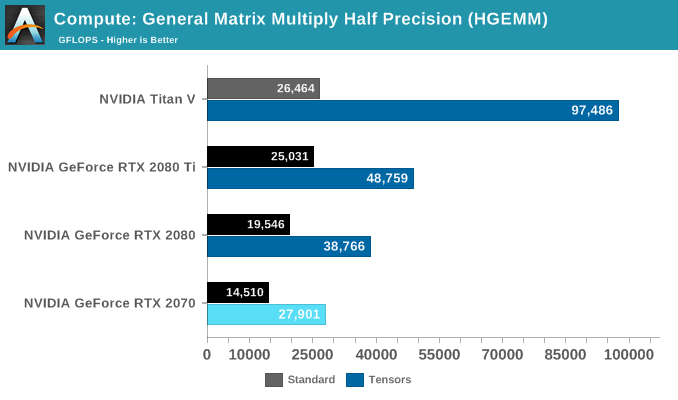
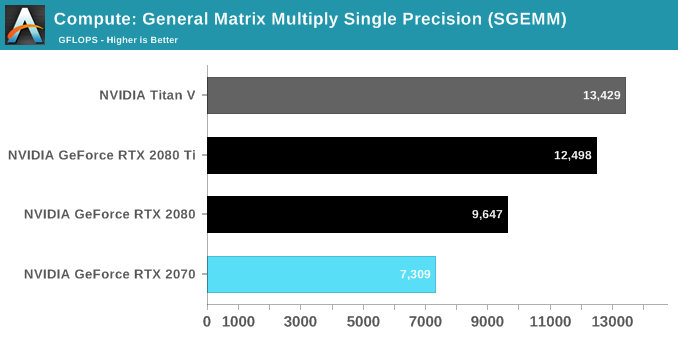
At reference specifications, peak theoretical tensor throughput is around 107.6 TFLOPS for the RTX 2080 Ti, 80.5 TFLOPS for the RTX 2080, and 59.7 TFLOPS for the RTX 2070. Unlike the 89% efficiency with the Titan V's 97.5 TFLOPS, the RTX cards are essentially at half that level, with around 47%, 48%, and 45% efficiency for the RTX 2080 Ti, 2080, and 2070 respectively. A Turing-optimized binary should bring that up, though it is possible that the GeForce RTX cards may not be designed for efficient tensor FP16 operations as opposed to the INT dot-product acceleration. After all, the GeForce RTX cards are for consumers and ostensibly intended for inferencing rather than training, which is the reasoning for the new INT support in Turing tensor cores.
In terms of SGEMM efficiency though, the RTX 2070 is hitting a ridiculous 97% of its touted 7.5 TFLOPS, though to be fair the reference specifications here are done manually rather with a reference vBIOS. The other two GeForce RTX cards are at similar 90+% levels of efficiency, though a GEMM test like this is specifically designed for maximum utilization.
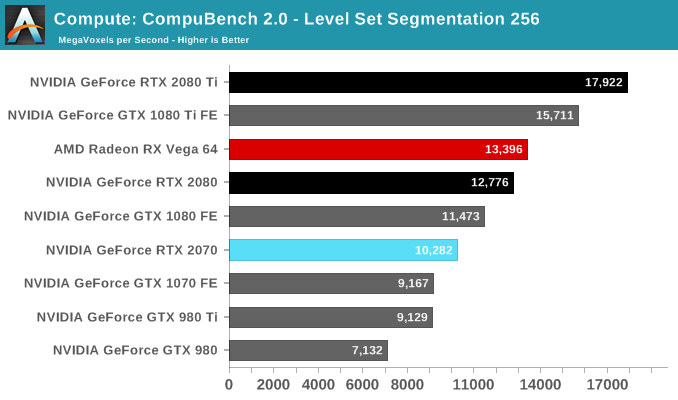
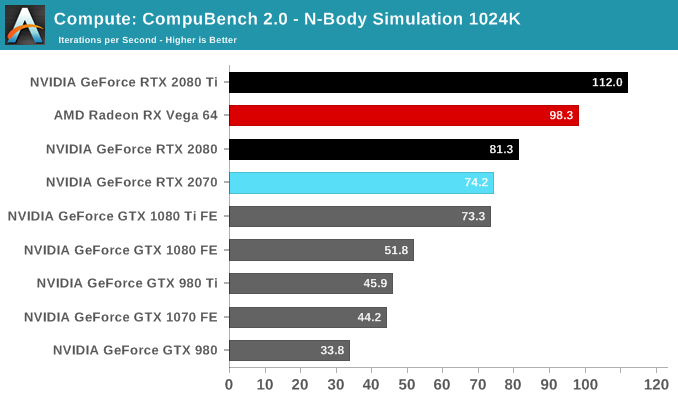
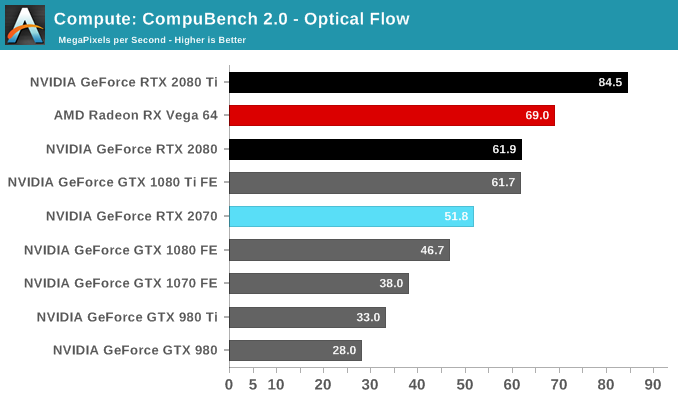
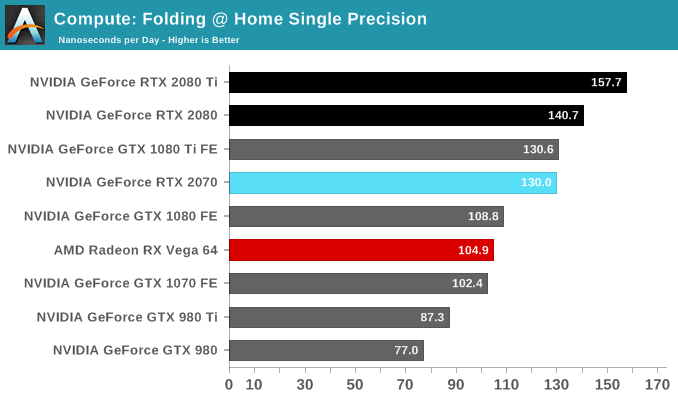
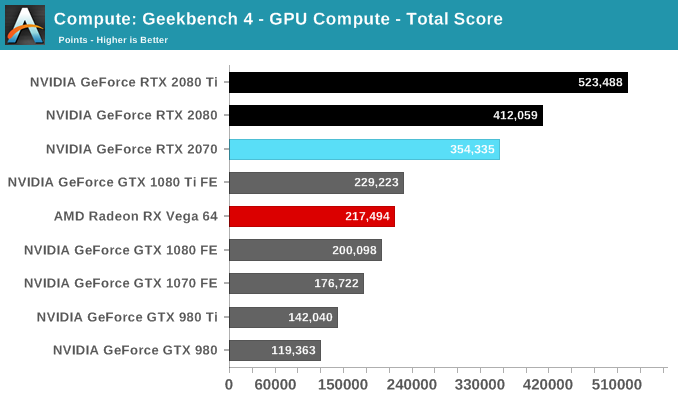
The breakdown of the GB4 subscores seems to reveal a similar uplift like we spotted with the Titan V, which had scored in excess of 509,000 points. We'll have to investigate further but Turing and Volta are clearly accelerating some of these workloads beyond what was capable in Pascal and Maxwell.
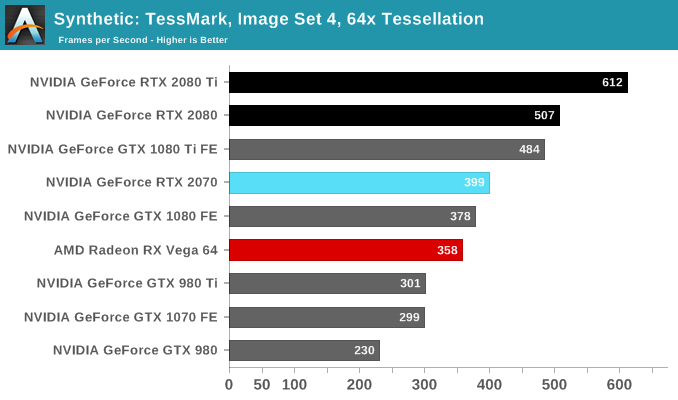
Given that TU106 has 75% of the hardware resources of TU104, the tessellation performance is in line with expectrations. For reference, we noted earlier that the Titan V scored 703 while the Titan Xp scored 604.
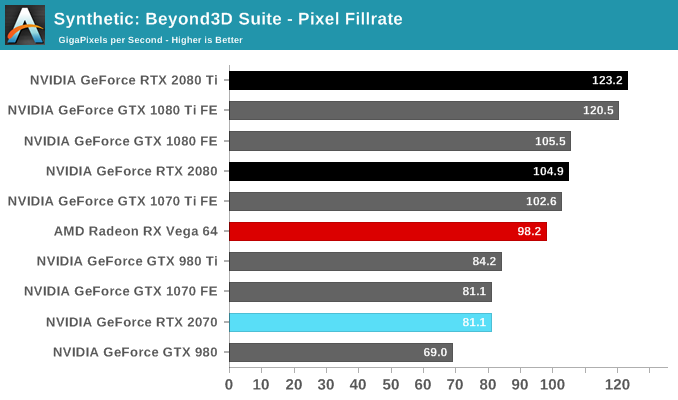
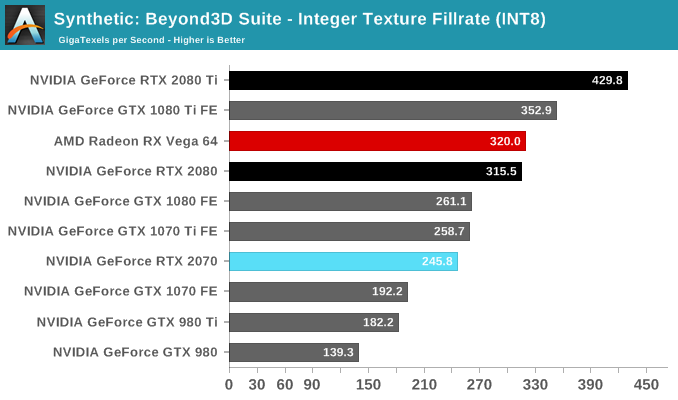










121 Comments
View All Comments
FreckledTrout - Wednesday, October 17, 2018 - link
That pretty much sums it up.Doesn't this entire generation seem like it should have been made on 7nm to keep die sizes and costs down along with the heat?
Wwhat - Wednesday, October 17, 2018 - link
in games*You forgot to add.
Personally I'm curious about what non-gaming software will use those tensor and RT cores and what that will bring. I mean if for example Blender traced 3 times faster it would be quite a thing for Blender users. Same for video editing software users I imagine.
And then there's the use for students and scientist.
And the whole wave of AI stuff that people are now getting into.
It's funny because I would have thought that Anadtech would the site that was the one with not exclusively gamers and people using graphics cards exclusively for gaming, but going through the comments you'd think this was a gamer-oriented site - and a gamers site only.
althaz - Wednesday, October 17, 2018 - link
So that's a solid "no" then? You can get better performance for significantly less. This card isn't targeted at me (a 1080 owner), but until the ray tracing stuff starts to be worth anything, this card seems just too overpriced for a reasonable person to consider.ballsystemlord - Wednesday, October 17, 2018 - link
Spelling and grammar corrections.I did not read through the whole thing, but this is what I did find.
"The card is already coming in with a price premium so it's important to firmly faster."
Missing "be".
"The card is already coming in with a price premium so it's important to be firmly faster."
"For the RTX 2070, 4K and 1440p performance once agani settles near the GTX 1080." Right letters, wrong ordering
"For the RTX 2070, 4K and 1440p performance once again settles near the GTX 1080."
Also, I am of the opinion that you should focus your reviews on the performance of the cards vs. price/speed positioning/slot. For example, you could note that the 20 series tends to have better 99th percentile frame rates. This was a big win for the Vega when it first came out. I have not actually crunched the numbers to see if the Vega is better or worse than the 20 series. The calculation would be (minimum*100)/average == % a lower value being a larger discrepancy (worse).
FullmetalTitan - Thursday, October 18, 2018 - link
Certainly makes me feel better about pulling the trigger on a $525 overclocked 1080 with a free game last weekend. 2070s are certainly less abundant, and definitely not for $525. The premium only buys 5-10% performance at base clocks, not worth another $100lenghui - Friday, October 19, 2018 - link
Dear AT, please stop auto-playing your "Buy the Right CPU" video. Pleeeeeeeeeeeze. It's driving me away from your site. I am on my last thread.DominionSeraph - Friday, October 19, 2018 - link
Unfortunately the design makes it look like a terrible XFX AMD card.rtho782 - Saturday, October 20, 2018 - link
2070 incurs less of a perf hit in HDR? Ryan seems to think it has no impact: https://twitter.com/RyanSmithAT/status/80115626506...Luke212 - Thursday, October 25, 2018 - link
Nvidia gimped the tensor cores on consumer RTX, that’s why tensor core benchmarks are half a titan V or Quadro RTX. It can’t do FP32 accumulate full speed.dcole001 - Friday, October 26, 2018 - link
I currently have GTX 1070 and just can't justify upgrading due to the fact that Ray Tracing is currently not being used in any games right now. yes there is 15 - 25 FPS performance boost running 1440P still not worth $499 - $599 cost. Wait a year and this Video Card will drop and there actually might be some games taking advantage of Ray Tracing.